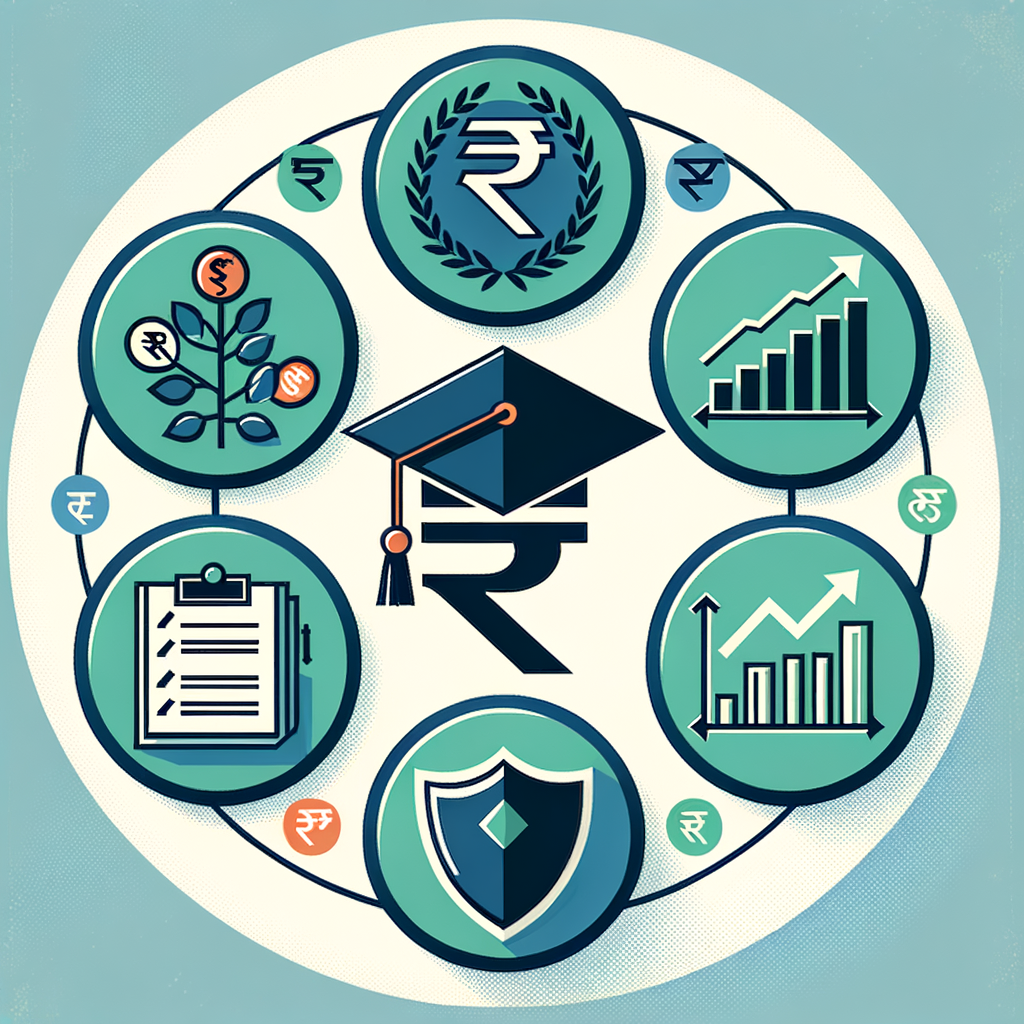A Practical Guide to Debt Management Strategies for Students and Recent Graduates in India
The excitement of landing your first job in India is a feeling like no other. The first salary, the newfound independence, and the dreams of a bright future are exhilarating. But this excitement is often met with a sobering reality: the daunting arrival of education loan EMIs and credit card bills. If this sounds familiar, you are not alone. With the rising costs of higher education, student debt has become a common challenge for young Indians stepping into the professional world. However, with the right approach, this challenge can be effectively overcome. This article provides clear, actionable debt management strategies to help you take control of your finances, build a strong foundation for your future, and make the process of managing debt for students in India less intimidating.
Why You Can’t Afford to Ignore Debt After Graduation
Ignoring debt is like ignoring a small leak in a boat; eventually, it can sink your entire financial journey. For recent graduates, understanding the long-term consequences of debt is the first step toward financial discipline. Proactively managing what you owe isn’t just about making payments; it’s about securing your future opportunities and peace of mind.
The Critical Role of Your CIBIL Score
Think of your CIBIL score (also known as a credit score) as your financial report card. It’s a three-digit number, ranging from 300 to 900, that tells lenders how responsible you are with credit. Financial institutions in India, from major banks to fintech lenders, heavily rely on this score to evaluate loan applications. A high CIBIL score signifies a trustworthy borrower.
Timely repayment of your education loan EMIs and credit card bills is the single most important factor in building a positive credit history and a high CIBIL score. This score is your key to accessing future credit at favourable terms. Whether you plan to buy a car, purchase a home, or seek a loan to start your own business, a strong score can save you lakhs of rupees in interest over the years. Conversely, defaulting on payments, even for a short period, can severely damage your score, making it difficult and more expensive to secure loans for years to come. You can check your score and report on the official CIBIL website.
How Debt Impacts Your Long-Term Financial Goals
Unmanaged debt can cast a long shadow over your personal and professional aspirations. The burden of high monthly payments can significantly delay major life milestones that you dream of. For instance, a significant portion of your income going towards EMIs can make it challenging to save for a down payment on a home, fund your wedding, or pursue a master’s degree abroad. This constant financial strain also reduces your disposable income, which directly impacts your ability to save and invest for the future. Effective financial planning for graduates in India must begin with a clear plan to tackle existing liabilities, as this frees up capital that can be used to build wealth through investments like mutual funds or stocks, ultimately delaying your journey towards financial independence.
Common Types of Debt for Young Indians
For most students and recent graduates, debt typically falls into a few common categories:
- Education Loans: These are often the first major loan for any individual. They are structured with a moratorium period, which is a grace period after your course ends (usually 6-12 months) before repayments begin. Understanding when your EMI payments start is crucial for budgeting your first salary. Additionally, you can benefit from tax deductions under Section 80E: Claiming Deductions on Education Loan Interest.
- Credit Card Debt: The convenience of credit cards is undeniable, but they come with a significant risk: extremely high-interest rates. The Annual Percentage Rate (APR) on credit cards can range from 30% to over 45%. Many fall into the “minimum payment trap,” where paying only the minimum amount due leads to the outstanding balance accumulating massive interest, making the debt very difficult to clear.
- Personal Loans/Consumer Durable Loans: As you start earning, you might be tempted to take out personal loans for travel or consumer durable loans for the latest gadgets. While these can be useful, they add to your monthly obligations and should be approached with caution, ensuring the EMI fits comfortably within your budget.
5 Actionable Debt Management Strategies for Quick Results
Feeling overwhelmed is natural, but getting started is easier than you think. The key is to move from worry to action. These five practical steps will help you create a clear roadmap to becoming debt-free.
Step 1: Create a Comprehensive Debt Inventory
You cannot manage what you do not measure. The very first step is to get a crystal-clear picture of everything you owe. This exercise is about confronting the numbers head-on to eliminate any guesswork. Create a simple spreadsheet or even a list in a notebook to compile all your debts.
For each debt, you should have the following columns:
- Lender Name: (e.g., HDFC Bank, SBI, Bajaj Finserv)
- Type of Debt: (e.g., Education Loan, Credit Card, Personal Loan)
- Total Amount Owed: The current outstanding principal.
- Interest Rate: The annual percentage rate (APR). This is the most critical number.
- Minimum Monthly Payment (EMI): The mandatory amount you must pay each month.
Once completed, this debt inventory will serve as your command center. It shows you exactly where you stand and allows you to prioritize your efforts effectively. This overview is the foundational step for creating effective debt management strategies for students in India and gives you the clarity needed to make informed decisions.
Step 2: Build a Realistic Budget (The 50/30/20 Rule)
Once you know what you owe, the next step is to understand where your money is going. A budget is not about restriction; it’s about empowerment. It gives you control over your income and allows you to direct your money towards your goals, with debt repayment being a top priority. For a first-time earner, the 50/30/20 rule is an excellent and simple framework to start with.
Here’s how it works:
- 50% for Needs: This portion of your take-home salary should cover your absolute essentials. This includes rent, groceries, utility bills (electricity, internet), transportation, and your minimum loan payments (EMIs).
- 30% for Wants: This category is for lifestyle expenses that make life enjoyable but aren’t strictly necessary. This includes dining out, entertainment, shopping, hobbies, and subscriptions.
- 20% for Savings & Debt Repayment: This is the powerhouse of your financial plan. This 20% should be allocated to your financial goals, with aggressive debt repayment being the primary focus.
To accelerate your journey out of debt, you can adapt this rule. For instance, you could aim for a 50/20/30 split, reducing your ‘Wants’ to 20% and increasing your ‘Savings & Debt Repayment’ to 30%. The more you can allocate here, the faster you will become debt-free. You can use popular Indian budgeting apps like Walnut or Money Manager to track your spending and stick to your plan.
Step 3: Choose Your Repayment Strategy: Avalanche vs. Snowball
With a budget in place, you can now decide how to allocate the extra money you’ve set aside for debt repayment. There are two popular and effective methods: the Debt Avalanche and the Debt Snowball. The decision between the Debt Snowball vs. Debt Avalanche: Which Strategy Is Best for You? depends on your personality and what motivates you. These debt strategies for recent graduates India are designed to provide a structured approach to repayment.
| Feature | Debt Avalanche Method | Debt Snowball Method |
|---|---|---|
| Primary Focus | Pay off debts with the highest interest rates first. | Pay off the smallest debts first, regardless of interest rate. |
| Process | Make minimum payments on all debts. Use all extra money to attack the debt with the highest interest rate. Once it’s cleared, roll that entire payment amount over to the next-highest interest rate debt. | Make minimum payments on all debts. Use all extra money to attack the smallest debt. Once it’s cleared, roll that entire payment amount over to the next-smallest debt. |
| Financial Benefit | Mathematically optimal. Saves you the most money in interest over the long term. | May cost more in total interest compared to the Avalanche method. |
| Psychological Benefit | Requires more discipline as it might take longer to clear the first debt. | Provides quick, motivating “wins” early on, which can help you stay committed. |
| Best For | Individuals who are disciplined, motivated by numbers, and want to minimize the total interest paid. | Individuals who need early victories to stay motivated and build momentum. |
Example: Imagine you have three debts:
- Credit Card: ₹20,000 at 24% interest
- Personal Loan: ₹50,000 at 14% interest
- Education Loan: ₹5,00,000 at 9% interest
- Using the Avalanche Method, you would focus all extra funds on the Credit Card (24% interest) first.
- Using the Snowball Method, you would focus all extra funds on the Credit Card (₹20,000 balance) first. In this specific case, the target is the same, but if the personal loan was smaller than the credit card debt, the Snowball method would target the personal loan first, even with its lower interest rate.
Step 4: Explore Loan Consolidation and Refinancing Options
Managing multiple EMIs with different due dates can be stressful and confusing. This is where consolidation and refinancing can be powerful student debt solutions in India. While often used interchangeably, they are distinct concepts.
- Debt Consolidation: This involves taking out a new, single loan to pay off multiple existing debts. It’s most commonly used for high-interest debts like credit cards. For example, you could take a personal loan at 15% to pay off three different credit cards with interest rates of 24%, 30%, and 36%. This simplifies your payments into one EMI and can significantly lower your overall interest rate.
- Loan Refinancing: This is specific to a single loan. You essentially replace your existing loan with a new one that offers better terms, primarily a lower interest rate. This is a very common and effective strategy for education loans. If you took your loan a few years ago and your credit score has improved since you started working, you may be eligible for a much lower interest rate from another bank or NBFC.
Pros and Cons of these debt relief options for students in India:
- Pros: A single, manageable EMI, a potentially lower interest rate which saves money, and a fixed repayment schedule.
- Cons: There might be be processing fees for the new loan, and if you opt for a longer tenure to reduce the EMI, you might end up paying more in total interest over the life of the loan.
Step 5: Increase Your Income to Accelerate Repayment
While budgeting and strategizing are about optimizing your expenses, the other side of the equation is increasing your income. Earning more money provides you with extra firepower to throw at your debts, drastically shortening your repayment timeline. As a recent graduate, you have skills that are in demand.
Consider these practical ideas to boost your income:
- Freelancing: Offer your core skills (writing, graphic design, coding, social media management) on platforms like Upwork or Fiverr.
- Tutoring: If you excelled in certain subjects, you can tutor school or college students online or offline.
- Side-Hustle: Turn a hobby into a small business. This could be anything from photography and baking to selling art online.
- Skill-based Gigs: Participate in paid surveys, become a virtual assistant, or do transcription work.
The key is to dedicate 100% of the income from these side hustles directly to your debt repayment. This ensures that the extra effort you’re putting in translates directly into achieving your goal of becoming debt-free faster.
Building a Debt-Free Future: Habits to Adopt Now
Clearing your current debts is a major victory, but adopting healthy financial habits is what ensures you stay debt-free in the long run. These practices will form the bedrock of a secure financial future.
Prioritize Building an Emergency Fund
Life is unpredictable. An unexpected medical expense, a sudden job loss, or an urgent home repair can strike at any time. Without a safety net, these emergencies often force people to take on new debt, undoing all their hard work. An emergency fund is your buffer against this. The process of Building an Emergency Fund While Managing Debt is a crucial habit to develop. Aim to save 3-6 months’ worth of essential living expenses (rent, utilities, groceries, EMIs) in a separate, easily accessible savings account. Start small if you have to—even ₹1,000 a month makes a difference. Automate the transfer from your salary account every month so you can build it consistently without thinking about it.
Practice Responsible Credit Card Usage
Credit cards are tools, not free money. When used wisely, they can help you build your credit score and offer rewards. When used irresponsibly, they lead to a crushing debt cycle.
Follow these golden rules:
- Pay the Total Balance in Full: Always aim to pay the entire outstanding amount by the due date, not just the minimum amount. This prevents any interest from being charged.
- Keep Credit Utilization Low: Your credit utilization ratio is the percentage of your total available credit that you are using. For example, if your credit limit is ₹1,00,000 and you have an outstanding balance of ₹20,000, your utilization is 20%. Experts recommend keeping this ratio below 30% to maintain a healthy credit score.
- Don’t Use Credit for Cash: Avoid using your credit card to withdraw cash from ATMs, as these transactions attract very high fees and interest from day one.
Conclusion: Take Control with Smart Debt Management Strategies
Navigating the world of personal finance as a student or recent graduate can feel overwhelming, but it doesn’t have to be. By taking a proactive approach, you can transform debt from a source of stress into a manageable part of your financial journey. Remember the key steps: assess exactly what you owe, create a realistic budget to control your spending, choose a powerful repayment strategy like the Avalanche or Snowball method, and start building healthy habits like creating an emergency fund. Implementing these proactive debt management strategies is the first and most critical step towards achieving long-term financial freedom, building wealth, and realizing all your life goals.
Navigating your finances as a recent graduate can be complex. If you need help with personalized financial planning for graduates in India or tax filing, TaxRobo’s experts are here to guide you. Contact us today for a consultation!
Frequently Asked Questions (FAQs)
Q1: What happens if I default on my student loan EMI in India?
Answer: Defaulting on your student loan EMI has several serious consequences. Immediately, the bank will charge you late payment fees. Your default will be reported to credit bureaus like CIBIL, causing a significant drop in your credit score. You will also start receiving reminder calls and notices from the bank. A poor repayment history can severely hinder your ability to get approved for any future loans, such as a home loan or car loan, for many years.
Q2: Can I prepay my education loan without any penalty in India?
Answer: Yes, in most cases. As per guidelines issued by the Reserve Bank of India (RBI), banks are not permitted to charge a prepayment penalty or foreclosure charges on floating interest rate term loans. Since most education loans in India are on a floating rate, you can typically prepay them in part or full without any penalty. However, it is always crucial to read your loan agreement and confirm the specific terms and conditions with your bank before making a prepayment. For more details, you can refer to official notifications like this RBI circular.
Q3: Is it better to invest or pay off student debt first?
Answer: This is a common dilemma, and the answer depends on a simple comparison of numbers. The general rule of thumb is to compare your loan’s interest rate to the potential after-tax returns you expect from your investments. If the interest rate on your debt is high (e.g., a personal loan at 14% or credit card debt at 24%), it is almost always financially wiser to prioritize paying off that debt. The interest saved is a guaranteed “return.” If your debt has a relatively low-interest rate (e.g., an education loan at 8-9%), and you are confident you can earn a higher return by investing in assets like equity mutual funds, you might consider a balanced approach of investing while paying your EMIs.
Q4: How can I improve my CIBIL score quickly after clearing my debts?
Answer: Improving your CIBIL score is a gradual process that requires consistent financial discipline. After clearing your debts, you can accelerate the process by:
- Continuing to make all other payments on time: This includes any remaining credit card bills or other utility payments.
- Keeping your credit utilization ratio low: If you have a credit card, try not to use more than 30% of your available limit.
- Not closing old credit accounts: The length of your credit history matters. Keeping an old, well-managed credit card account open can positively impact your score.
- Periodically checking your credit report: Review your report for any errors or inaccuracies through the official CIBIL website and get them rectified immediately.



